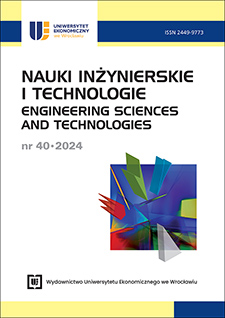Bakteriofagi i ich potencjał w leczeniu infekcji oraz zwiększaniu bezpieczeństwa żywności
DOI:
https://doi.org/10.15611/nit.2024.40.11Słowa kluczowe:
bakteriofagi, terapia fagowa, antybiotykooporność, bezpieczeństwo żywnościAbstrakt
Cel: Bakteriofagi, jako wirusy atakujące bakterie, stanowią obiecującą alternatywę w walce z narastającą opornością bakterii na antybiotyki. Celem pracy jest przedstawienie aktualnego stanu wiedzy na temat bakteriofagów, ich budowy, cykli życiowych oraz potencjalnych zastosowań w medycynie i przemyśle spożywczym.
Metodyka: Przegląd literatury naukowej dotyczącej mechanizmów działania bakteriofagów, ich selekcji pod kątem zastosowań terapeutycznych oraz obecnych ograniczeń w ich wdrażaniu. Analizie poddano również dostępność bibliotek fagowych oraz wyzwania związane z opracowaniem standardów terapii fagowej.
Wyniki: Bakteriofagi wykazują wysoką specyficzność wobec wybranych bakterii, co pozwala na ich precyzyjne zastosowanie w eliminacji patogenów. Jednak brak publicznych bibliotek fagowych oraz potrzeba opracowania kryteriów selekcji skutecznych fagów stanowią istotne bariery w rozwoju tej metody.
Implikacje i rekomendacje: Dalsze badania nad terapią fagową powinny koncentrować się na optymalizacji metod izolacji, charakterystyki oraz oceny skuteczności bakteriofagów w warunkach klinicznych. Konieczne jest także rozwinięcie baz danych bakteriofagów, co zwiększyłoby dostępność i standaryzację terapii.
Wartość: Praca podkreśla znaczenie bakteriofagów w nowoczesnej medycynie i biotechnologii oraz wskazuje na kluczowe kierunki przyszłych badań, które mogą przyczynić się do skutecznego wdrożenia terapii fagowej jako alternatywy dla antybiotyków.
Pobrania
Bibliografia
Ackermann, H.-W. (2003). Bacteriophage Observations and Evolution. Research in Microbiology, 154(4), 245-251. https://doi.org/10.1016/S0923-2508(03)00067-6
Aksyuk, A. A. i Rossmann, M. G. (2011). Bacteriophage Assembly. Viruses, 3(3), 172-203. https://doi.org/10.3390/v3030172
Alves, D., Cerqueira, M. A., Pastrana, L. M. i Sillankorva, S. (2020). Entrapment of a Phage Cocktail and Cinnamaldehyde on Sodium Alginate Emulsion-Based Films to Fight Food Contamination by Escherichia coli and Salmonella Enteritidis. Food Research International, 128. https://doi.org/10.1016/j.foodres.2019.108791
Brzozowska, E., Bazan, J. i Gamian, A. (2011). Funkcje białek bakteriofagowych. Postępy Higieny i Medycyny Doświadczalnej, 65, 167-176. https://doi.org/10.5604/17322693.936090
Chan, B. K., Turner, P. E., Kim, S., Mojibian, H. R., Elefteriades, J. A. i Narayan, D. (2018). Phage Treatment of an Aortic Graft Infected with Pseudomonas aeruginosa. Evolution, Medicine and Public Health, 1, 60-66. https://doi.org/10.1093/emph/eoy005
Fleming, A. (1941). Penicillin. British Medical Journal, 2(4210), 386. https://www.ncbi.nlm.nih.gov/pmc/articles/PMC2162878/
Ganeshan, S. D. i Hosseinidoust, Z. (2019). Phage Therapy with a Focus on the Human Microbiota. Antibiotics, 8(3), 31. https://doi.org/10.3390/antibiotics8030131
Garvey, M. (2022). Bacteriophages and Food Production: Biocontrol and Bio-Preservation Options for Food Safety. Antibiotic, 11(10), 1324. https://doi.org/10.3390/antibiotics11101324
Gibb, B., Hyman, P. i Schneider, C. L. (2021). The Many Applications of Engineered Bacteriophages – an Overview. Pharmaceuticals, 14(7), 634. https://doi.org/10.3390/ph14070634
Gouvêa, D. M., Mendonça, R. C. S., Soto, M. L. i Cruz, R. S. (2015). Acetate Cellulose Film with Bacteriophages for Potential Antimicrobial Use in Food Packaging. LWT, 63(1), 85-91. https://doi.org/10.1016/j.lwt.2015.03.014
Karthik, K., Muneeswaran, N., Appavoo, E. i Semmannan, K. (2014). Bacteriophages: Effective Alternative to Antibiotics. Advances in Animal and Veterinary Sciences, 2, 1-7. https://doi.org/10.14737/journal.aavs/2014/2.3s.1.7
Kathayat, D., Lokesh, D., Ranjit, S. i Rajashekara, G. (2021). Avian Pathogenic Escherichia coli (APEC): An Overview of Virulence and Pathogenesis Factors, Zoonotic Potential, and Control Strategies. Pathogens (Basel, Switzerland), 10(4), 467. https://doi.org/10.3390/pathogens10040467
Keen, E. i Dantas, G. (2018). Close Encounters of Three Kinds: Bacteriophages, Commensal Bacteria, and Host Immunity. Trends in Microbiology, 26. https://doi.org/10.1016/j.tim.2018.05.009
Kortright, K. E., Chan, B. K., Koff, J. L. i Turner, P. E. (2019). Phage Therapy: A Renewed Approach to Combat Antibiotic-Resistant Bacteria. Cell Host Microbe, 25(2), 219-232. https://doi.org/10.1016/j.chom.2019.01.014
Kutateladze, M. i Adamia, R. (2008). Phage Therapy Experience at the Eliava Institute. Médecine et Maladies Infectieuses, 38(8), 426-430. https://doi.org/10.1016/j.medmal.2008.06.023
Lewis, R., Bolocan, A. S., Draper, L. A., Paul Ross, R. i Hill, C. (2019). The Effect of a Commercially Available Bacteriophage and Bacteriocin on Listeria monocytogenes in Coleslaw. Viruses, 11(11). https://doi.org/10.3390/v11110977
Lin, D. M., Koskella, B. i Lin, H. C. (2017). Phage Therapy: An Alternative to Antibiotics in the Age of Multi-Drug Resistance. World Journal of Gastrointestinal Pharmacology and Therapeutics, 8(3), 162-173. https://doi.org/10.4292/wjgpt.v8.i3.162
Liu, N., Lewis, C., Zheng, W. i Fu, Z. Q. (2020). Phage Cocktail Therapy: Multiple Ways to Suppress Pathogenicity. Trends in Plant Science, 25(4), 315-317. https://doi.org/10.1016/j.tplants.2020.01.013
Ma, Y. X., Wang, C. Y., Li, Y. Y., Li, J., Wan, Q. Q., Chen, J. H., Tay, F. R. i Niu, L. N. (2020). Considerations and Caveats in Combating ESKAPE Pathogens Against Nosocomial Infections. Advanced Science, 7(1). https://doi.org/10.1002/advs.201901872
Malik, D. J., Sokolov, I. J., Vinner, G. K., Mancuso, F., Cinquerrui, S., Vladisavljevic, G. T., Clokie, M. R. J., Garton, N. J., Stapley, A. G. F. i Kirpichnikova, A. (2017). Formulation, Stabilisation and Encapsulation of Bacteriophage for Phage Therapy. Advances in Colloid and Interface Science, 249, 100-133. https://doi.org/10.1016/j.cis.2017.05.014
Mansour, N. (2017). Bacteriophages Are Natural Gift, Could we Pay Further Attention. Journal of Food Microbiology, 1, 22. Międzybrodzki, R., Borysowski, J., Weber-Dąbrowska, B., Fortuna, W., Letkiewicz, S., Szufnarowski, K., Pawełczyk, Z., Rogóż, P.,
Kłak, M., Wojtasik, E. i Górski, A. (2012). Chapter 3. Clinical Aspects of Phage Therapy. W: M. Łobocka i W. Szybalski (red.), Advances in Virus Research (t. 83, s. 73-121). Academic Press. https://doi.org/https://doi.org/10.1016/B978-0-12-394438-2.00003-7
Narayanan, K. B., Bhaskar, R. i Han, S. S. (2024). Bacteriophages: Natural Antimicrobial Bioadditives for Food Preservation in Active Packaging. International Journal of Biological Macromolecules, 276. https://doi.org/10.1016/j.ijbiomac.2024.133945
Rahmani, R., Zarrini, G., Sheikhzadeh, F. i Aghamohammadzadeh, N. (2015). Effective Phages as Green Antimicrobial Agents Against Antibiotic-Resistant Hospital Escherichia coli. Jundishapur Journal of Microbiology, 8(2). https://doi.org/10.5812/jjm.17744
Ricci, A., Allende, A., Bolton, D., Chemaly, M., Davies, R., Girones, R., Herman, L., Koutsoumanis, K., Lindqvist, R., Nørrung, B., Robertson, L., Ru, G., Sanaa, M., Simmons, M., Skandamis, P., Snary, E., Speybroeck, N., Kuile, B. Ter, Threlfall, J. i Fernández Escámez, P. S. (2017). Scientific Opinion on the Update of the List of QPS-Recommended Biological Agents Intentionally Added to Food or Feed as Notified to EFSA. EFSA Journal, 15(3). https://doi.org/10.2903/J.EFSA.2017.4664
Schooley, R. T., Biswas, B., Gill, J. J., Hernandez-Morales, A., Lancaster, J., Lessor, L., Barr, J. J., Reed, S. L., Rohwer, F., Benler, S., Segall, A. M., Taplitz, R., Smith, D. M., Kerr, K., Kumaraswamy, M., Nizet, V., Lin, L., McCauley, M. D., Strathdee, S. A. i Hamilton, T. (2017). Development and Use of Personalized Bacteriophage-Based Therapeutic Cocktails to Treat a Patient with a Disseminated Resistant Acinetobacter baumannii Infection. Antimicrobial Agents and Chemotherapy, 61(10). https://doi.org/10.1128/AAC.00954-17
Stratakos, A. C. i Grant, I. R. (2018). Evaluation of the Efficacy of Multiple Physical, Biological and Natural Antimicrobial Interventions for Control of Pathogenic Escherichia coli on Beef. Food Microbiology, 76, 209-218. https://doi.org/10.1016/j.fm.2018.05.011
Summers, W. C. (2012). The Strange History of Phage Therapy. Bacteriophage, 2(2), 130-133. https://doi.org/10.4161/bact.20757
Twort, F. W. (1936). Further Investigations on the Nature of Ultra-Microscopic Viruses and Their Cultivation. Journal of Hygiene, 36(2), 204-235. https://doi.org/10.1017/S0022172400043606
Verbeken, G., Huys, I., Pirnay, J. P., Jennes, S., Chanishvili, N., Scheres, J., Górski, A., De Vos, D. i Ceulemans, C. (2014). Taking Bacteriophage Therapy Seriously: A Moral Argument. BioMed Research International. https://doi.org/10.1155/2014/621316
Weber-Dabrowska, B., Mulczyk, M. i Górski, A. (2000). Bacteriophage Therapy of Bacterial Infections: An Update of Our Institute’s Experience. Archivum Immunologiae et Therapiae Experimentalis, 48(6), 547-551.
Weinbauer, M. G. (2004). Ecology of Prokaryotic Viruses. FEMS Microbiology Reviews, 28(2), 127-181. https://doi.org/10.1016/j.femsre.2003.08.001
Zheng, C., Wang, G., Liu, J., Song, C., Gao, H. i Liu, X. (2013). Characterization of the Major Capsid Genes (g23) of T4-Type Bacteriophages in the Wetlands of Northeast China. Microbial Ecology, 65(3), 616-625. https://doi.org/10.1007/s00248-012-0158-z
Pobrania
Opublikowane
Numer
Dział
Kategorie
Licencja
Prawa autorskie (c) 2025 Agata Milcarz

Utwór dostępny jest na licencji Creative Commons Uznanie autorstwa – Na tych samych warunkach 4.0 Miedzynarodowe.





